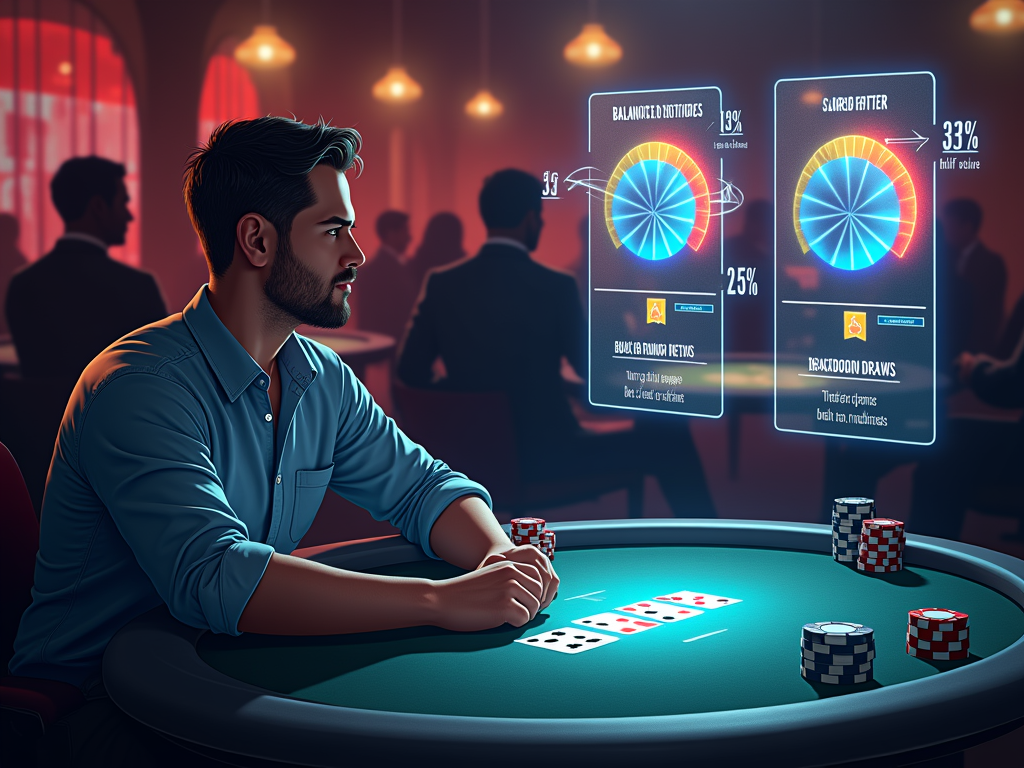Mastering Winning Poker Strategy in 2024
Playing winning poker in 2024 demands mastery of both mathematical concepts and psychological elements. Game Theory Optimal (GTO) play forms the foundation of advanced strategy, creating solid baseline approaches that opponents can’t exploit. I combine theoretical study with practical implementation while using tracking software to gain a competitive advantage.
Key Takeaways
- GTO poker focuses on creating unexploitable strategies with optimal bluffing frequencies (33.3% bluffs to 66.7% value bets for pot-sized bets)
- Player profiling through HUD stats and tendencies allows for effective exploitation of opponents’ leaks
- ICM considerations dramatically impact tournament decision-making, especially near pay jumps
- Building balanced ranges requires adjusting bluff-to-value ratios based on board texture and position
- Mental game mastery and tilt control are crucial for maintaining consistent performance during long sessions
Combining GTO and Exploitative Poker
GTO principles guide my decisions, but I adapt based on each opponent’s playing style. This flexible approach helps identify and exploit weaknesses while staying protected against skilled players. My strategy relies on tracking software to collect data, spot patterns, and make informed adjustments.
Adjusting Strategy for Tournament Play
Tournament poker adds another layer with ICM pressure affecting every decision. Near the money bubble or final table, chip preservation becomes critical. I modify my ranges and risk tolerance based on stack sizes and payout structures.
Effective Range Construction
Range construction requires precise attention to position, stack depth, and board textures. I maintain appropriate bluff-to-value ratios to stay balanced yet profitable. This lets me apply maximum pressure while remaining difficult to counter.
The Importance of the Mental Game
Strong mental game skills support consistent execution. I practice focused play, emotional control, and proper bankroll management to sustain long-term success. These elements create a complete strategy for today’s competitive poker landscape.
Playing Like a GTO Master: A Scientific Approach to Perfect Poker
Game Theory Optimal (GTO) poker represents the pinnacle of strategic play, with its foundation built on the Nash Equilibrium concept. When I’m implementing GTO strategies at the table, I focus on creating a position where my opponents can’t profit by adjusting their strategy against me – that’s the core essence of Nash Equilibrium in poker.
Mastering Mixed Strategies and Balanced Frequencies
Mixed strategies form the backbone of advanced poker gameplay and strategic decision-making. I’ve learned that playing the same hand differently in similar situations helps maintain unpredictability. For instance, with pocket Kings on a wet board, I might alternate between betting and checking at specific frequencies to stay balanced.
The mathematics behind optimal bluffing frequencies is particularly fascinating. When making pot-sized bets, the GTO-optimal bluffing frequency sits at exactly 33.3%, with value bets making up the remaining 66.7% of my betting range. Here’s how I structure my betting patterns for optimal GTO play:
- Value bets should represent two-thirds of my betting actions
- Bluffs need to make up one-third of my betting frequency
- My bet sizing stays consistent whether I’m bluffing or value betting
- I maintain these ratios across different board textures
Perfect GTO implementation isn’t realistic for human players – the calculations are too complex to process in real-time. Instead, I focus on understanding these core principles and applying them as closely as possible during play. This practical approach to GTO helps me make more profitable decisions while keeping my strategy balanced and unexploitable.
The key is finding the sweet spot between theoretical perfection and practical application. I work on incorporating these concepts gradually, starting with basic frequencies and slowly adding more complex elements as they become second nature. This measured approach helps me build a solid foundation in GTO principles while maintaining effective gameplay.
Maximizing Edge Through Advanced Player Profiling
Online poker gives you a massive advantage through the use of tracking software and HUD stats. I’ve found that proper player profiling can significantly boost win rates when you know the key metrics to focus on.
Reading Stats for Maximum Profit
The first stat I check is the Fold to Continuation Bet percentage. Players who fold more than 70% to c-bets are prime targets for profitable exploitation. Against these opponents, I’ll increase my c-betting frequency significantly, even with complete air.
Here are the core stats I analyze for developing targeted counter-strategies:
- VPIP (Voluntarily Put Money in Pot): Players above 35% are likely playing too loose and can be exploited with 3-bets
- PFR (Pre-Flop Raise): A PFR over 28% indicates aggressive tendencies that can be countered with well-timed 4-bets
- 3-Bet Percentage: Opponents over 12% are likely 3-betting too wide, making them vulnerable to 4-bet bluffs
- Aggression Factor (AF): High AF players can be trapped with strong hands and induced to bluff
Calling stations require a completely different approach. I substantially reduce my bluffing frequency and instead focus on extracting maximum value with strong hands. Against these players, I’ll value bet thinner than normal, sometimes betting three streets with just top pair good kicker.
The power of exploitative play comes from making significant deviations from GTO (Game Theory Optimal) strategies when I spot major leaks. For example, if I notice a player never folds to 3-bets in position, I’ll adjust by 3-betting only value hands and completely removing bluffs from my range.
Real-time stat tracking through a HUD is crucial for mastering online poker strategy and maximizing profits. By constantly analyzing these numbers and adjusting accordingly, I can make better decisions and exploit opponents’ tendencies more effectively.
I pay special attention to how players react in 3-bet and 4-bet pots, as these high-variance situations often reveal the biggest leaks. When I spot a player who consistently over-folds to 3-bets (above 70%), I’ll implement an aggressive 3-betting strategy with a wider range of hands.

Tournament ICM Mastery: When Math Trumps Intuition
Independent Chip Modeling (ICM) shapes critical tournament decisions where standard chip-based math falls short. In high-pressure spots, especially near pay jumps, ICM calculations provide a concrete edge over purely instinct-driven plays.
Understanding ICM Through Real Examples
Let’s break down a common 3-player Sit & Go scenario with a 70%/30% payout structure. Picture this: Player A has 5,000 chips, Player B has 3,000 chips, and you’re sitting with 4,000 chips. While chip-wise you’re in second place, your actual dollar equity isn’t simply 30% of the prize pool.
Here’s what makes tournament poker fascinatingly complex:
- A double-up from 4,000 to 8,000 chips doesn’t double your money equity
- Going from 4,000 to 0 chips costs you more in real money than the chip percentage suggests
- Medium stacks face intense ICM pressure from larger stacks, particularly near pay jumps
I’ve found that many players misunderstand the relationship between chip equity (cEV) and actual money equity ($EV). For instance, holding AK in the small blind against a big stack’s shove from the button might be profitable in chip equity but a clear fold when considering ICM implications.
The big stack’s leverage becomes particularly powerful near pay jumps. With 50% of the chips, they can apply immense pressure on medium stacks who must consider survival over chip accumulation. You’ll often need to fold hands that would be clear calls in a cash game setting.
Let’s look at the key spots where ICM dictates strategy:
- Bubble play: Tighten your calling ranges significantly when shorter stacks are at risk
- Pay jump transitions: Adjust shoving ranges based on stack size distributions
- Final table dynamics: Factor in pay jumps when considering marginal spots
- Short stack defense: Calculate risk-reward ratios accounting for tournament equity
As a tournament poker player working to master advanced concepts, I’ve learned that ICM awareness separates consistent winners from break-even players. The ability to make mathematically sound decisions under ICM pressure often matters more than playing perfect poker in terms of pure chip equity.
Remember, defending blinds against a big stack’s late position raises requires much stronger holdings when ICM is a factor. A hand like AJ suited, normally a standard defend, might become a fold if pay jumps loom and medium stacks are involved.
Short stacks face different ICM considerations. They can often shove wider than ICM calculators suggest because of fold equity and the opportunity to chip up quickly. However, calling all-ins requires much tighter ranges when factoring in tournament equity.
By studying these spots and running ICM calculations regularly, you’ll develop stronger intuition for these complex situations. The key is recognizing when standard chip-based math needs to yield to ICM considerations, particularly in tournaments with steep payout structures.

Building Unbeatable Ranges Through Balance and Deception
Creating balanced poker ranges isn’t just about playing strong hands – it’s about crafting a strategic mix of value bets and bluffs that keep opponents guessing. I’ve found that proper bet sizing directly connects to the number of bluffs needed in your range to stay unexploitable.
Essential Bet Sizing and Bluffing Ratios
When using pot-sized bets, I need to include 33% bluffs in my betting range to prevent opponents from profitably folding everything except their strongest hands. For half-pot bets, that ratio drops to 25% bluffs. Here’s a practical breakdown of how to structure betting ranges:
- On a K72 rainbow board as the preflop raiser, I’ll continue betting with all my kings, sets, and strong draws while mixing in strategic bluffs with suited connectors and backdoor draws
- When holding top set on dry boards, I merge my range by sometimes checking back the flop to protect my medium-strength hands
- With medium pairs like JJ on an A-high board, I’ll often check behind to control pot size and prevent opponents from exploiting an overly aggressive strategy
- Facing aggression on draw-heavy boards, I adjust my bluff-to-value ratio lower since opponents have more natural calling hands
- In position against tight players, I increase my bluffing frequency since they’re more likely to fold marginal holdings
The texture of the board heavily influences optimal bluffing frequencies. On dry, unconnected boards, I can bluff more frequently since opponents have fewer natural calling hands. However, on coordinated boards with many straight and flush possibilities, I reduce my bluffing since opponents must call with more hands to prevent exploitation.
Protection plays a crucial role in range construction. By sometimes checking back strong hands, I shield my medium-strength holdings from exploitation while keeping my checking range strong enough to profitably call bets. This balanced approach makes me much harder to play against compared to always betting my strong hands.
Through consistent application of these mathematical ratios and strategic concepts, I can build ranges that maximize profit while minimizing exploitability. The key is maintaining proper bet sizing relative to pot size and adjusting bluffing frequency based on board texture and opponent tendencies. For a deeper look at mastering poker fundamentals, check out my complete guide on becoming a winning poker player both live and online.

Advanced Tools for the Modern Player
Modern poker demands a sophisticated approach, and I’ve found that leveraging advanced tools can create a significant competitive edge. From solvers to tracking software, these instruments help develop a deeper strategic understanding and refine decision-making processes.
Strategic Software Integration
Poker solvers have transformed how I analyze hands and develop strategies. While PioSOLVER and GTO+ offer powerful insights, they’re not magic bullets. The key is understanding their limitations and applying their findings correctly. I’ve learned to focus on common spots and basic solutions first, gradually building complexity as my grasp of fundamental concepts improves.
Here are the essential tools and metrics I monitor for optimal performance:
- Tracking Software (PT4 or HEM3) – These platforms capture and analyze vital opponent tendencies
- VPIP (Voluntary Put In Pot) – Players above 40% are typically exploitable and loose
- 3-Bet Percentage – Anything above 9% indicates an aggressive player worthy of attention
- PioSOLVER – Perfect for deep-diving into specific spots and understanding GTO principles
- GTO+ – Excellent for quick solutions and mobile study sessions
When using tracking software, I ensure my sample sizes are substantial enough for reliable data interpretation. For most stats, I aim for a minimum of 1,000 hands before making definitive reads on opponents. Some advanced stats might require up to 5,000 hands for accurate assessment.
The real challenge lies in mastering poker strategy implementation during live play. I’ve developed a system of studying solver spots away from the table, then creating simple rules and guidelines I can apply in real-time. This approach bridges the gap between theoretical understanding and practical application.
For the HUD stats, I pay special attention to players whose numbers deviate significantly from the baseline. A VPIP over 40% often signals recreational players who are overplaying hands, while a 3-bet percentage above 9% typically indicates an aggressive regular who might be applying pressure in incorrect spots.
Remember that these tools supplement poker knowledge rather than replace it. I’ve noticed many players become overly reliant on solvers without understanding the underlying concepts. The goal is to use these resources to enhance decision-making capabilities while maintaining flexibility in live play situations.

Meta-Game Warfare and Mental Mastery
Meta-game poker strategy demands a deep understanding of psychological dynamics and multiple levels of thinking. I’ve found that successful players regularly operate on three distinct levels: what cards they hold, what their opponents might have, and what their opponents think they have. This layered thinking creates opportunities for sophisticated plays and strategic deception.
Advanced Mental Game Components
Before diving into complex strategies, having the right bankroll foundation is critical. For cash games, I recommend maintaining at least 50 buy-ins to handle variance effectively. Tournament players need even more padding — a minimum of 100 buy-ins helps absorb the higher variance in MTT play.
Here are the key mental game elements I’ve identified as crucial for advanced players:
- Tilt Management Variations
- Loser’s tilt: Occurs after significant losses, leading to aggressive revenge plays
- Winner’s tilt: Overconfidence after winning streaks causing loose play
- Entitlement tilt: Frustration when “deserved” wins don’t materialize
- Injustice tilt: Emotional response to perceived unfair beats or coolers
- Table Image Manipulation
- Creating false patterns to exploit later
- Using previous hands to set up future plays
- Switching gears based on opponents’ perception
- Leveraging history-based reads for maximum effect
The distinction between A-game and C-game states significantly impacts performance. I’ve learned to spot the signs of declining play quality: decreased focus, emotional decision-making, or rushed actions. When I notice these indicators, taking a break helps reset my mental state and prevents further performance decay.
Table image exploitation requires careful attention to opponents’ reactions and adjustments. I might deliberately show down a bluff early in a session to set up paid-off value bets later. Or I’ll maintain a tight image for hours before executing a perfectly timed big bluff. These advanced poker tactics require patience and precise timing to execute successfully.
Mental mastery also means understanding your optimal playing conditions. This includes recognizing when you’re in peak form versus when your game is deteriorating. I track my playing sessions and note the circumstances that lead to my best and worst performances. This self-awareness helps maintain consistent profitability and prevents major downswings.
The meta-game extends beyond individual hands to encompass entire sessions or tournament runs. I pay attention to how opponents adjust their strategies over time and look for opportunities to counter-adjust effectively. This might mean switching from a LAG to TAG style mid-session or adjusting my 3-betting range based on how the table perceives my recent actions.
Mastering these mental game concepts creates a competitive edge that’s hard to quantify but impossible to ignore. By staying aware of these psychological factors while maintaining solid technical play, I can maximize my win rate and minimize the impact of variance on my results.
Sources:
Applications of No-Limit Hold’em by Matthew Janda
The Mental Game of Poker by Jared Tendler
Modern Poker Theory by Michael Acevedo
Expert Heads Up No Limit Hold’em by Will Tipton
Run It Once
Upswing Poker
Raise Your Edge





